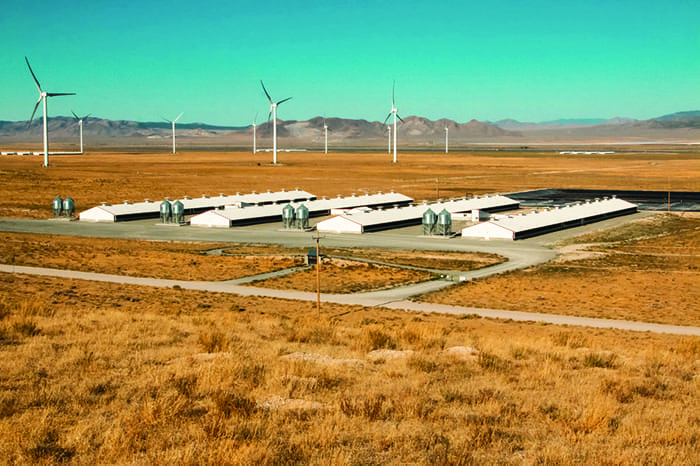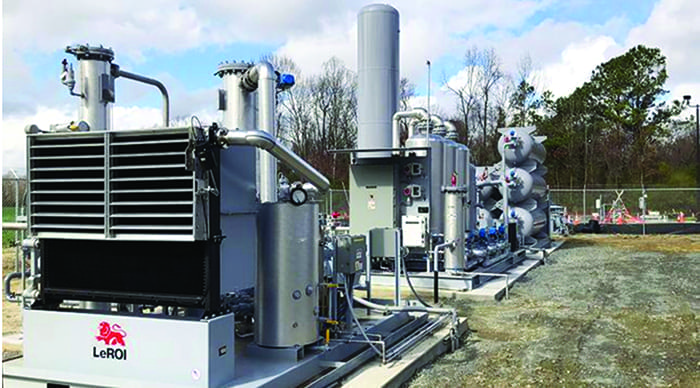Last December, two giant Virginia-headquartered firms—energy company Dominion Energy and food manufacturer Smithfield Foods—announced completion of a novel renewable natural gas (RNG) facility in Milford, southwestern Utah. While the Milford facility is the first of four similar projects that Align Renewable Natural Gas—a joint venture formed in November 2018 between Dominion and Smithfield—is spearheading, it is just one of a string of new, notable developments that suggest RNG is quickly gaining ground as the energy transition unfolds.
RNG is essentially a gaseous fuel derived from biogenic or other renewable sources, which can be “upgraded” and processed to pipeline-compatible, near-pure methane. According to the World Resources Institute (WRI), landfills account for the bulk of current RNG production, mainly because they already have methane collection mechanisms. A smaller share of RNG is derived via anaerobic digestion (AD) of solid organic matter removed in the wastewater treatment process at municipal water resource recovery plants, animal manure at livestock farms, and food waste at other facilities. RNG can also come from gasification of “dry” organic wastes, such as agricultural and forestry residues.
A Low-Carbon Natural Gas
As Karen Crippen, Research and Development director at GTI’s Energy Supply & Conversion division, explained during a recent webinar, RNG differs from natural gas in that it’s “nearly all methane, none of the extra hydrocarbon seen in natural gas. It also contains some small amounts of trace constituents, depending on the biogas source. Great strides have been made in the past decade with numerous testing programs, so we now have a good understanding of what the trace constituents in RNG are,” she said. Modern biogas “upgrading” technologies typically used to achieve pipeline-quality standards include membranes, pressure swing adsorption, solvent scrubbing, and water scrubbing. While these can add to production costs, the resulting RNG can be a form of gas that combines low to negative lifecycle carbon emissions with the high energy density, storage capability, and transportability of natural gas.
These environmental attributes are attractive to both policymakers and investors alike because they offer both a pathway for the natural gas industry to meet energy sector decarbonization goals, as well as future resilience of the energy system by providing a locally sourced supply of clean energy. According to David Cox, founder and chief financial officer at the RNG Coalition, a member-led nonprofit organization dedicated to RNG advancement, the recent drive for decarbonization is fueling a boom in the production of RNG. “RNG has had a fairly consistent 30% growth rate (by volume) in recent years,” he said. “Ten years ago, there were 30 RNG facilities in North America. Today we have 157 operating facilities—with another 76 under construction.”
Investors are bullish on the low-carbon gas because it is economic today, said Stifel Equity Research in a recent white paper. “In 2020, dairy and landfill gas projects earned average price realizations of $100/MMBtu and $30/MMBtu, respectively, well above their respective average cost of supply. Based on our assessment of over 20 projects across the primary RNG feedstocks (landfill, animal manure, wastewater), we estimate the industry generates project-level [internal rate of returns (IRRs)] in the 10% to 65% range assuming strip prices, and current federal and state programs. We expect returns to improve as operators advance anaerobic digestion technology, improve operating efficiency, and better integrate digestate sales into their operations.”
RNG Represents an 80-Fold Growth Potential
It also offers remarkable growth potential. While the International Energy Agency projects an 18-fold increase in RNG supply by 2040, Stifel suggests dairy and swine farms alone represent an 80-fold increase in potential projects.
 |
|
1. Align Renewable Natural Gas’ Milford facility captures methane from hog farming operations via covered manure lagoons or digesters. The gas is then transported by a low-pressure biogas transmission line to a central conditioning facility, where it is processed and then delivered to end-users through existing underground pipelines. Courtesy: Align Renewable Natural Gas |
Align RNG’s Milford project in Utah (Figure 1) represents a snapshot of such facilities. The project consists of a network of 26 family farms that raise hogs under contract with Smithfield. At full capacity, the project could produce about 650 MMBtu per day of RNG—enough biomethane to heat more than 3,000 homes and businesses. Align RNG is now looking to complete 12 to 16 RNG projects over the next decade at farm networks in North Carolina and Virginia.
 |
|
2. The Optima KV project in Duplin County, North Carolina, captures methane from the hog waste of five local farms. The project injects the renewable natural gas into the Piedmont Natural Gas system, which transports it to Duke Energy’s Smith Energy Complex in Richmond County, where it has been used to produce electricity since 2018. Under North Carolina’s Renewable Energy and Energy Efficiency Portfolio Standard law, Duke must generate 0.2% of its retail sales in the state from swine waste by 2024. Courtesy: Duke Energy |
Demand for the gas is set to increase too. In 2011, nearly all RNG projects operating in the U.S. were providing RNG for power production offsite. Driven by policy (Figure 2), most notably the federal Renewable Fuel Standard (RFS) and California’s Low Carbon Fuel Standard (LCFS), by 2017, 76% of RNG projects were converting RNG into transportation fuels, particularly for natural gas vehicles designed for long-haul and heavy-duty applications, while 24% generated power offsite.
“Unlike the transportation sector, use of RNG as a direct fuel in stationary end uses relies largely on existing infrastructure, thanks to the substantial reliance on natural gas to meet heating and other building energy needs in many regions of the U.S. In the long term, this infrastructure is likely to be gradually phased out as electrification and efficiency efforts move forward,” noted the WRI.
In recent years, meanwhile, an increasing number of natural gas utilities—a total of 15 as of September 2020—and states had either active or under-development voluntary RNG procurement programs for residential, commercial, and industrial customers. Industrial consumers, which consume more natural gas than any other sector for heating, onsite power generation, or as an intermediate feedstock for the production of fertilizers and other chemical products, represent a latent market, the WRI suggests.
Looking ahead, RNG may be used to produce hydrogen, which may in turn be used for fuel cell vehicles, for combustion-based heat in stationary applications, as a feedstock in industrial processes, as a storage medium, or as fuel for electricity. Bloom Energy and California Bioenergy, for example, are developing dairy projects to convert biogas to power directly using fuel cell technology; the power produced will generate credits for California’s LCFS. Bloom estimates the technology could produce 320 MW of dairy biogas, which could be used for onsite power generation or for electric vehicle (EV) charging stations.
Stifel, notably, expects the proliferation of LCFS programs and the growth of EV demand to be “game-changers.” “Beginning with policy, we expect the expansion of LCFS programs across the U.S., with Oregon and Washington being the next to implement programs formally,” it said. “Regarding EV demand, Bloomberg Intelligence forecasts [an estimated 22-fold] increase in gigawatts consumed by EV chargers from 2020 to 2040.”
The investment firm also suggested RNG potential in the power sector, which consumed 12 times more natural gas than the transportation sector in 2019, is still untapped. “We expect [renewable portfolio standard (RPS)] programs similar to Oregon’s SB 98, a first-of-a-kind bill that sets 30-year targets for gas utilities to procure RNG and renewable hydrogen for customers, to drive demand growth in power generation markets,” it said.
Crucial Challenges Facing RNG Power
However, Stifel cautions that RNG power, which is classified as renewable power, could face an uphill battle owing to incentives that are designed to boost solar and wind. “Due to increasing renewable electricity supply from solar and wind, [renewable energy credits (RECs)] under RPS programs have historically traded at a significant discount to D3 [Renewable Identification Number (RIN)] prices under the [federal Renewable Fuel Standard]. The premium received for RINs explain why most of the RNG is consumed by the transportation sector,” it said. “Assuming no change in the pricing dynamics between RECs and RINs, and the continued proliferation of solar and wind capacity, we do not foresee RNG playing a significant role in the generation of renewable electricity,” it said.
RNG’s growth potential is so promising, gas pipeline companies are actively making enhancements to business practices to accommodate it. Energy infrastructure giant Kinder Morgan earlier this year noted about 78 million cubic feet per day (MMcfd) of RNG was produced in 2019—which accounted for less than 0.1% of its natural gas supply for the year. “Between landfills, dairy farms, swine farms, and other RNG sources, the National Renewable Energy Laboratory estimates RNG has the potential to scale up to 1.15 billion cubic feet per day (Bcfd) in the U.S., or about 1.25% of the 2019 U.S. natural gas supply,” the company said.
To prepare for a potential expansion in RNG market demand, since 2018, Kinder Morgan has put five RNG sites in service on its El Paso Natural Gas, Tennessee Gas Pipeline, and Colorado Interstate Gas (CIG) pipeline systems. “These locations are capable of moving 18 MMcfd of RNG, which could have accounted for nearly 25% of the market share in 2019,” it said.
According to Stifel, however, the additional infrastructure associated with connecting exponentially more RNG to existing natural gas pipelines could pose high costs and long lead times. Differences in U.S. pipeline specifications also create another challenge, owing in part to RNG’s slightly lower (and varying) Btu value when compared to geologic natural gas. Yet another challenge is that biogas feedstock quality can also vary over time, requiring significant treatment investments. Finally, the RNG industry continues to grapple with a common misconception that RNG is sub-par quality compared to fossil natural gas.
—Sonal Patel is senior associate editor for POWER.
"gas" - Google News
May 03, 2021 at 11:40AM
https://ift.tt/3xGZI6f
Renewable Natural Gas Emerging as Serious Decarbonized Gas Contender - POWER magazine
"gas" - Google News
https://ift.tt/2LxAFvS
https://ift.tt/3fcD5NP
Bagikan Berita Ini















0 Response to "Renewable Natural Gas Emerging as Serious Decarbonized Gas Contender - POWER magazine"
Post a Comment